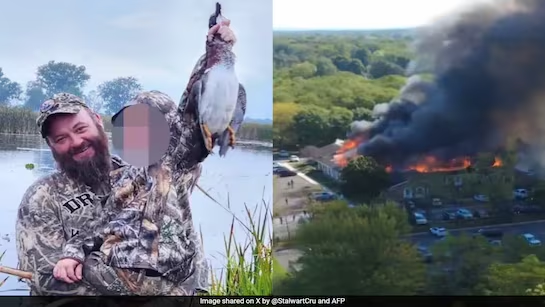A Compressed Recount: The Catastrophe in Brief
On September 28, 2025, calamity descended upon a sanctuary of The Church of Jesus Christ of Latter-day Saints in Grand Blanc Township, Michigan. A lone assailant michigan church shooting weaponized his pickup truck, crashing it into the holy edifice before discharging rifle fire amid worshippers and igniting flames with accelerant. Authorities confirmed no fewer than four lives extinguished and eight grievously wounded. The aggressor himself perished in a gunfight with swiftly arriving officers. Federal entities, inclusive of the FBI, were summoned to bolster the probe.
Chronicle of the Assault
Prelude, eruption, and law enforcement reprisal
Dispatch transcripts alongside survivor testimony sketch a harrowing tableau: by late morning, alarms pierced through to emergency channels. Congregants recalled a truck cleaving into sacred walls, fire blossoming like a malignant tide, and gunfire resounding. Police converged within minutes, engaging the gunman and terminating his rampage. Officials underscored the rapidity of their counteraction, though the tragedy unraveled with ferocious swiftness.
Eyewitness recollections
Witnesses conjure scenes of choking smoke, pandemonium, and terrified cries. Ordinary parishioners and neighbors morphed into impromptu medics, rendering assistance until ambulances arrived. These human vignettes reveal how swiftly sanctuary can devolve into turmoil, underscoring the necessity of vigilance and forethought.
Unmasking the Perpetrator
Identity and antecedents
The attacker has been identified as Thomas Jacob Sanford, aged 40, a resident of Burton, Michigan. Once a U.S. Marine, Sanford carried the legacy of overseas deployments. Investigators remain undecided whether ideology, grievance, or fractured psychology steered his violence.
Military tenure and communal threads
Reports delineate Sanford’s Marine service from 2004 to 2008, including an Iraq tour. Acquaintances portrayed him as a huntsman and outdoors devotee. Authorities now dissect his communications, affiliations, and recent conduct to discern whether radicalization or private vendetta animated his actions.
Methodology of Carnage
Vehicular strike, firearms, and incendiary tactics
Officials recount that Sanford plowed his truck into the church’s structure, then wielded an assault-style rifle against congregants, before kindling the building with gasoline. The unholy trinity of vehicle assault, ballistic terror, and arson magnified the devastation, crafting a mosaic of chaos nearly impervious to prevention.
Explosive suspicions
Bomb disposal squads were summoned after alleged improvised explosive devices were discovered in Sanford’s vehicle. While still provisional, such discoveries imply chilling layers of calculation and preparation.
Victims and Their Wounded Flock
Casualties and anguish
Initial figures stand at four deceased and eight wounded, though totals may evolve as forensic work continues. Regional hospitals received victims, with several clinging to fragile life. Families and entire congregations now navigate the abyss of grief.
Psychological and communal tremors
The desecration of sacred ground ripples beyond corporeal harm. Parishioners, who once sought solace, now find their faith’s hearth tainted by fear. Rebuilding stone and mortar is but a fraction of the task; reknitting security and spiritual serenity will demand far longer.
Institutional Response
Local law enforcement maneuvers
Grand Blanc Township officers engaged decisively, neutralizing the threat and orchestrating evacuation while fire brigades contested the inferno. Officials reassured the populace of no enduring menace yet cordoned the district for investigative rigor.
Federal reinforcement
Given the cocktail of firearms, arson, and potential explosives, the FBI and ATF entered the fray. The Bureau now treats the tragedy as targeted violence, excavating motive and probing for broader entanglements.
Political pronouncements
Michigan’s governor and national leaders mourned aloud, saluting first responders and grieving kin. Their words stitched symbolic unity, though communities yearn for tangible safeguards, not solely solemn rhetoric.
Unanswered Questions Under Scrutiny
Motive, digital trails, and domiciliary searches
Agents scour Sanford’s digital footprint, personal devices, and residence for clarifying evidence. Digital forensics may unravel the rationale faster than any manual search, revealing whether obsession, ideology, or fury seeded his intent.
Evidence consolidation
Though Sanford is deceased, evidence collation continues, ensuring a comprehensive public ledger. Should accomplices or conspiratorial whispers arise, charges will not end with his demise. Transparency is vital for bereaved families craving answers.
Sanctuaries Under Siege: A Disquieting Trend
Religious houses, embodiments of community and identity, tragically draw malice-seekers. Their openness, once a hallmark of welcome, simultaneously breeds vulnerability. The dilemma persists: safeguard without erecting fortresses.
In recent years, U.S. churches, synagogues, mosques, and temples have endured heightened threats. Many perpetrators emerge as solitary actors nursing grievances or tethered to ideology. Recognizing such contours equips communities to forge robust defense strategies.
Safeguarding Congregations
Modest yet potent measures
- Restrict access via controlled entry points.
- Enhance visibility: clear shrubbery, strengthen lighting.
- Establish swift communication systems — PA announcements, alert groups.
- Provide trauma kits and train congregants in first-aid.
- Deploy ushers as guardians of vigilance and evacuation guides.
Drills and partnerships
Routine safety exercises, coordinated with law enforcement, fortify readiness. Many precincts offer complimentary audits to religious institutions seeking counsel.
Broader Policy Fault Lines
Guns, psyche, and extremism
Such massacres reanimate disputes over firearm access — Michigan’s legal tapestry remains contested ground. Debate simmers between safeguarding rights and ensuring public safety.
Given Sanford’s military past, the discourse on veteran mental health resurfaces. Expanded counseling and social scaffolding could be preventative, though blanket stigmatization of veterans must be shunned.
Healing the Wounds
Immediate assistance
- Donate blood as hospitals request.
- Aid families with meals, childcare, and practical support.
- Contribute to certified relief funds, avoiding dubious appeals.
Long-term restoration
Survivors often require years of counseling, financial help, and spiritual mending. Established nonprofits and congregational networks generally steward this journey.
Media Conduct
Ethics of reportage
Journalism must prioritize dignity over spectacle. Avoid circulating grotesque imagery or conjecture. Uplift survivor voices and verified relief channels.
Guidelines for citizens
Cite official advisories, highlight legitimate fundraising portals, and refrain from speculation when discussing the tragedy online.
Reflections and Forward Steps
Immediate imperatives
Console the bereaved, bolster survivors, and support relief networks. Honor victims through vigils that console, not retraumatize.
Enduring resilience
Invest in preparedness, mental health discourse, and policies grounded in evidence, not partisanship. Communities recover by mourning and simultaneously reconstructing.
Epilogue
When blood is spilled in sacred halls, the shock reverberates through both faith and civic life. Yet from horror arises testament: the courage of responders, the solidarity of strangers, and the determination of the grieving to rebuild. The Grand Blanc massacre lays bare not only the fragility of sanctity but also the strength of community. To honor the fallen, action must replace rhetoric — ensuring fewer sanctuaries are marred by such darkness again.
FAQs
Q1: How many perished and how many were injured?
At least four fatalities and eight injuries were confirmed, though tallies may shift as the investigation solidifies.
Q2: Who was the perpetrator?
Authorities named Thomas Jacob Sanford, 40, a former Marine of Burton, michigan church shooting. His motives remain under examination.
Q3: Were explosives recovered?
Preliminary findings suggest potential improvised explosive devices in Sanford’s truck. Bomb squads were deployed, though evidence awaits confirmation.
Q4: Is there a lingering public danger?
Officials declared no continuing threat, urging residents only to avoid the secured vicinity during investigative operations.
Q5: How can civilians assist?
Offer aid via certified relief funds, volunteer at vetted groups, and donate blood if summoned. Always authenticate campaigns before contributing.




One thought on “Michigan church shooting: A Chronicle and Its Impact”